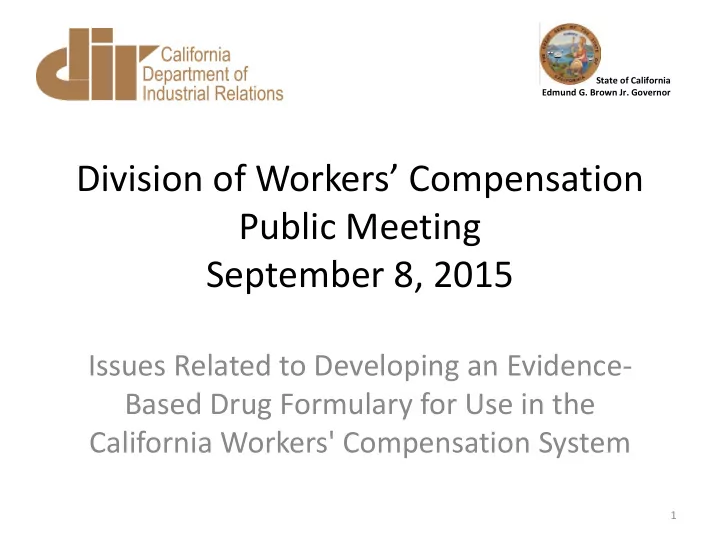

State of California Edmund G. Brown Jr. Governor Division of Workers’ Compensation Public Meeting September 8, 2015 Issues Related to Developing an Evidence- Based Drug Formulary for Use in the California Workers' Compensation System 1
What is a Formulary? • Preferred drug list • Continually updated with current evidence- based medicine and expert judgment • Policies for dispensing • Minimize administrative burden and cost • Protocols give access to non-formulary drugs when medically necessary 2
Why a Formulary? • Improved delivery of appropriate medication to injured workers – Reduced friction and delay • Clinical appropriateness – Most important in choosing the best treatment – Based on evidence review and physician decision • Cost – Important secondary concern when weighing equivalent drugs 3
Runaway Costs of Drugs • Prescription drugs spending is one of the fastest growing components of health care • Rising costs due to lack of pricing control, current spike in Big Pharma consolidation, and supply chain and manufacturing inefficiencies • Expensive drugs are sometimes chosen over equally effective, lower cost drugs 4
Estimated Costs • Generic drugs: 86% of medicines in U.S. • But no decrease in prescription drug spending • In 2012, Americans spent $263 billion – 11 percent more than the $236 billion in 2007 (Bloomberg 5/8/14) 5
Increased Drug Spending in California’s Workers’ Compensation System • Average 1 st year prescription payment rose 28% between accident year 2012 and 2013 • In 2013, prescription payments = $1 out of every $8 of medical benefits paid on a claim (CWCI 2014) • Workers’ Compensation is not alone: – CalPERS: $1.5 billion spent on prescription drugs in 2013 • Specialty drugs accounted for 0.57% of total prescriptions, but 20% of total drug costs (CalPERS 2014) – Medi-Cal: $4.4 billion spent on outpatient prescription drugs in 2007 (Medi-Cal 2009) 6
A Proposed Solution • Adopt an evidence-based drug formulary in the California Workers’ Compensation System 1. Focus on evidence-based decision making for drug inclusion Ensure clinical appropriateness, safety 2. More efficient use of health care dollars Maximized savings to employers and the state 7
Why Evidence-Based Formulary? • Utilizes the best scientific facts to determine preferred drugs that facilitate optimum health and reduce adverse impacts and disability • Ensures patient outcomes are the priority • Allows scientific assessment to be separated from cost decisions • Accepted methodology across jurisdictions 8
Who Uses Formularies? • Health plans • Pharmacy benefit management companies • Government agencies – Department of Defense, Medicare, Medicaid, Veterans Health Administration 9
Estimated Savings • Adoption of a state-mandated workers’ compensation drug formulary, depending on assumptions, could save California an estimated $124 million to $420 million per year. Source: CWCI 2014 Report to the Industry: Are Formularies a Viable Solution for Controlling Prescription Drug Utilization and Cost in California Workers’ Compensation? 10
Formulary Development Process Two separate processes Efficacy are involved: 1. Evidence-based review Cost of drugs to assess efficacy and appropriateness 2. Cost analysis to Formulary determine which drugs identified in first phase reflect the best price 11
Assessment of Appropriateness • Review of scientific research by evidence experts – E.g., at institutions such as the Drug Effectiveness Review Project (DERP) at Oregon Health and Science University – Opportunity for public comment • Recommendation for drug inclusion by clinical committee – E.g., Primary care and specialty physicians, pharmacists, nurses, legal experts – Assessment may include review of evidence-based reports, manufacturer dossiers, scientific literature, etc. – Develops initial list of recommended drugs 12
Cost Analysis of Recommendations • Conducted by a committee independent of evidence review • Prices are compared among drug classes • May consider supplemental rebate offers from manufacturers and other cost data 13
Formulary Review Process Evidence- Recommend Cost analysis Final list of based ations based of Agency recommend review of on the recommend adoption ations drug class evidence ations Ongoing review and revisions of formulary to consider new drugs and new evidence 14
Final List of Recommendations • Incorporates clinical appropriateness, safety and cost assessments • Submitted to agency leadership • Directors exert administrative decisions to review/approve proposed recommendations 15
Agency Adoption • Agency implements formulary and conducts education and outreach • Ongoing review and revisions of formulary to consider new drugs and new evidence 16
Building on Best Practices • Assess workers’ compensation formularies: – Positive and negative attributes – Estimated costs of implementation – Ease of adoption • Consider existing models such as Washington State, Texas State, group health and others 17
Discussion • Experiences with formularies and lessons learned • Benefits of formularies 18
Recommend
More recommend